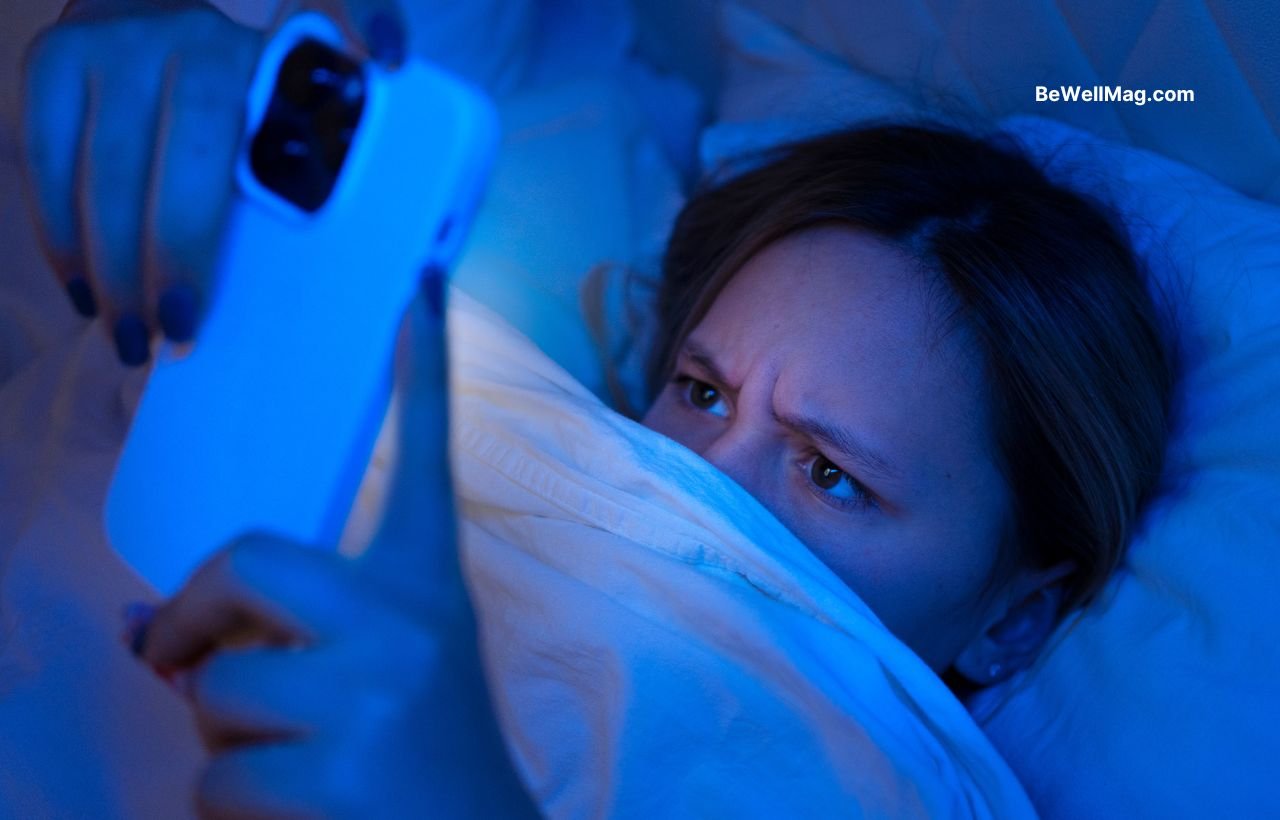Now Reading: How Blue Light Affects Sleep (And What to Do About It!)
- 01
How Blue Light Affects Sleep (And What to Do About It!)

How Blue Light Affects Sleep (And What to Do About It!)
Illuminating how blue light disrupts melatonin and sleep cycles—insightful details, practical tips, and innovative therapies for better rest.
Table of Contents
In today’s hyper-connected life, our evenings are flooded with the glow of screens—from smartphones to laptops. This ever-present blue light is subtly shifting our sleep cycles and overall well-being. Many of us remain unaware that the light we’re casually exposed to might be sabotaging our nights.
There’s hope, though. A little understanding and some proactive changes can help you reclaim peaceful sleep and optimal health. Let’s explore how blue light affects your brain and body clock, the risks it poses, and effective strategies to combat its downsides—all while learning about its surprising therapeutic benefits.
What Is Blue Light?
Blue light is a type of high-energy, short-wavelength light that is part of the visible light spectrum. Unlike other colors, its unique properties make it both beneficial and potentially disruptive, depending on the context of exposure. Here are the key points:
- Natural vs. Artificial Sources:
- Natural: Emitted by the sun, blue light helps regulate mood and alertness.
- Artificial: Comes from digital screens (smartphones, laptops, TVs), LED bulbs, and fluorescent lighting.
- Wavelength and Energy:
- Blue light has shorter wavelengths (approximately 400–490 nanometers) and higher energy compared to other visible light. This quality is close to ultraviolet light, making it potent enough to affect biological processes.
- Roles in Daily Life:
- In moderation during daylight, blue light boosts cognitive function and supports a healthy circadian rhythm.
- At night, however, it can interfere with melatonin production, delaying sleep onset and reducing sleep quality.
How It Shapes Your Brain and Sleep Patterns
Your brain relies on light cues to adjust your internal clock, known as the circadian rhythm. Here’s how blue light plays its part:
- Regulating Wakefulness: During the day, blue light signals your brain that it’s time to be active. It enhances alertness and cognitive processing, supporting an energized start to the day.
- Disrupting Sleep Signals: In the evening, exposure to blue light tricks your brain into thinking it’s still daylight. This suppression of melatonin delays your sleep cycle, making it harder for you to wind down and rest properly.
By altering these natural signals, blue light can shift the balance of your sleep-wake cycle—potentially contributing to ongoing sleep difficulties and long-term health concerns.
How Blue Light Disrupts Sleep
When nighttime comes, your body is programmed to begin winding down. Here’s a deeper look at what happens when blue light interferes:
- Melatonin Suppression: Melatonin is the hormone that signals bedtime. Blue light exposure, particularly from screens, significantly reduces melatonin production. This delay in melatonin release can keep you awake longer than necessary.
- Circadian Rhythm Shift: Even minimal exposure can shift your internal clock by several hours. This means that your body may think it’s still daytime, which hampers the natural cycle of deep sleep and REM sleep stages. Poor sleep quality affects memory consolidation, mood regulation, and overall health.
- Sleep Fragmentation: Not only does blue light delay sleep onset, but it also fragments your sleep throughout the night. The result is a pattern of restless sleep that leaves you feeling groggy and unfocused the next day.
Blue Light Exposure During Daytime
Not all blue light exposure is detrimental; in fact, it plays a crucial role during daylight. Here’s why daytime exposure can be beneficial:
- Boosting Alertness and Mood:
- Natural blue light from the sun elevates your mood and improves concentration.
- This exposure helps you stay active and alert during the hours when energy is needed most.
- Regulating the Circadian Rhythm:
- Daylight exposure strengthens your body’s natural clock, ensuring that melatonin is produced at the right time in the evening.
- Regular daytime exposure can reduce the risk of sleep disturbances at night.
- Building Resilience to Evening Exposure:
- When your circadian rhythm is in sync, occasional evening challenges (like a brief screen session) may have less severe effects.
- A balanced schedule of light exposure helps to maintain overall sleep quality.
Remember, the key is consistency. Enjoy the natural sunlight during the day, but be cautious as the evening approaches.
Blue Light Therapy
While the negative impact of blue light on sleep is well-documented, not all blue light exposure is harmful. In controlled settings, blue light therapy has proven to be beneficial for several conditions, including:
- Skin Treatments:
- Used to treat acne, sun damage, and even some pre-cancerous lesions.
- Works by targeting specific cells and reducing bacteria-causing skin issues.
- Seasonal Affective Disorder (SAD):
- Blue light therapy can be a mood enhancer, especially during darker months.
- Helps improve energy levels and counters depressive symptoms in people with SAD.
- Sleep and Circadian Rhythm Disorders:
- In some cases, exposure to carefully timed blue light in the morning can help reset your internal clock.
- This controlled exposure is often used as part of a treatment plan for people with irregular sleep patterns.
Blue light therapy illustrates that the same wavelength can be both a villain and a hero—depending on when, how, and why you’re exposed to it.
Strategies to Combat Blue Light Disruption
The good news is that with a few lifestyle adjustments, you can greatly reduce the negative impact of blue light. Consider these strategies:
- Set a Digital Sunset:
- Power down electronic devices at least 60 minutes before bed.
- Activate Blue Light Filters:
- Utilize built-in settings or apps on your devices to reduce blue light emissions.
- Blue Light Blocking Glasses:
- Invest in specialized glasses that filter out blue light during nighttime use.
- Adjust Indoor Lighting:
- Replace harsh overhead lights with warmer, dimmer bulbs during evening hours.
- Develop a Relaxing Bedtime Routine:
- Engage in calming activities like reading, meditating, or gentle stretching to signal your body that it’s time to wind down.
Expert Advice and Emerging Trends
Many sleep specialists and researchers are continuously studying the effects of artificial lighting on our health. Experts from institutions like Harvard Medical School emphasize the importance of reducing blue light exposure in the evening to maintain healthy sleep patterns.
Emerging trends include innovative smart home lighting systems that automatically adjust color temperature based on the time of day. These systems strive to balance natural light cycles with our digital lifestyles, easing the transition from wakefulness to rest with minimal effort.
When to Seek a Doctor
Sometimes, the impact of blue light might be more than just disruptive—it could signal underlying issues with your eye health or sleep quality. It’s important to know when professional guidance is necessary:
- Persistent Sleep Issues:
- Difficulty falling asleep or staying asleep over an extended period.
- Chronic fatigue or daytime drowsiness despite efforts to adjust routines.
- Severe Eye Strain or Discomfort:
- Regular headaches, dry or irritated eyes, or blurred vision after prolonged screen time.
- Persistent discomfort that doesn’t improve with simple remedies (like breaks or blue light filters).
- Changes in Vision:
- Noticeable changes such as blurred vision or dark spots can be a sign of more serious conditions.
- Any sudden vision changes should prompt a professional consultation immediately.
- Overall Health Concerns:
- If you’re experiencing mood changes, anxiety, or other symptoms that might be linked to disrupted sleep, it might be time to speak with a healthcare expert.
Consulting a doctor can provide personalized advice and, if necessary, additional solutions to minimize the impact of blue light on your life.
Conclusion
Blue light’s impact on our sleep and overall health is a multifaceted issue in our modern, digitally driven world. By understanding how blue light interferes with melatonin production and shifts your circadian rhythm, you can take informed steps toward a healthier sleep routine.
Whether it’s fine-tuning your digital habits, embracing blue light therapy for its positive effects, or simply adjusting your home environment, small changes can lead to significant improvements in the quality of your rest and daily energy. Embrace these insights and reclaim your nights—restful sleep is within reach.
Disclaimer: This content is for informational purposes only and should not be considered professional or medical advice. Please consult a qualified expert for guidance tailored to your specific circumstances.











